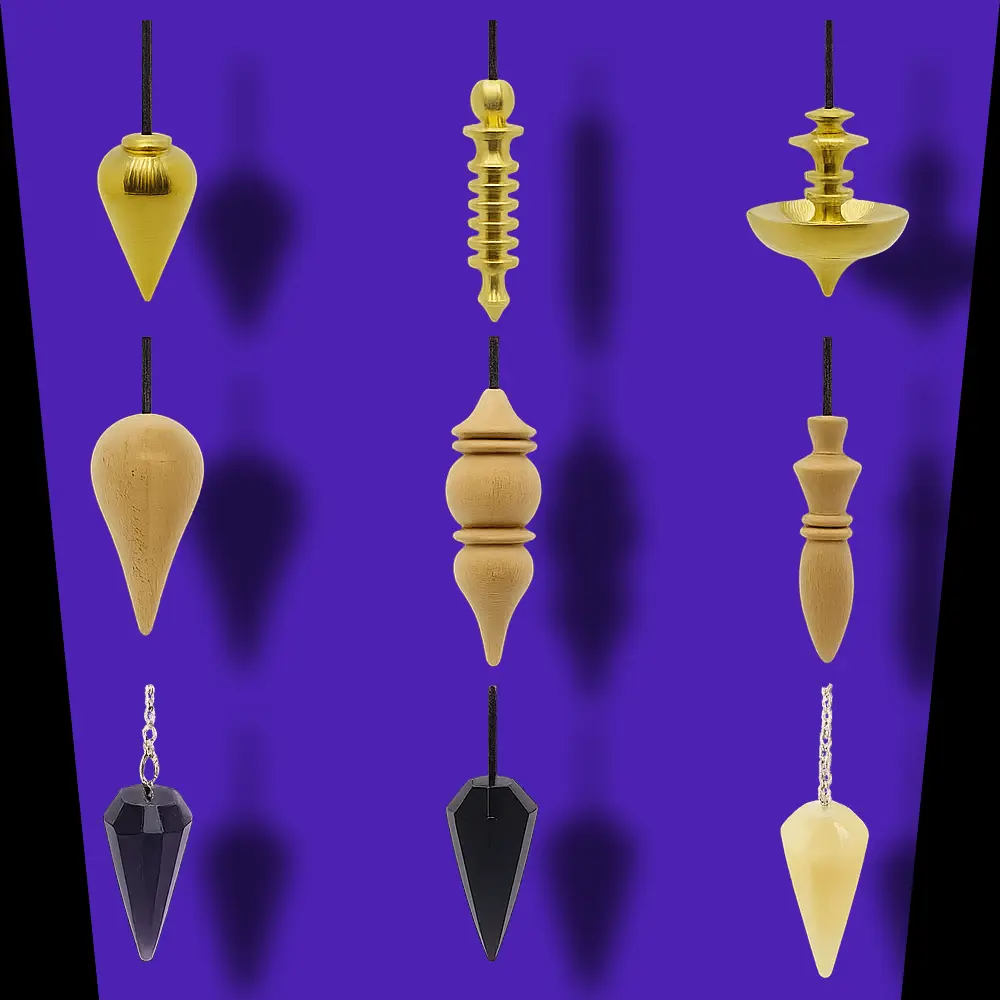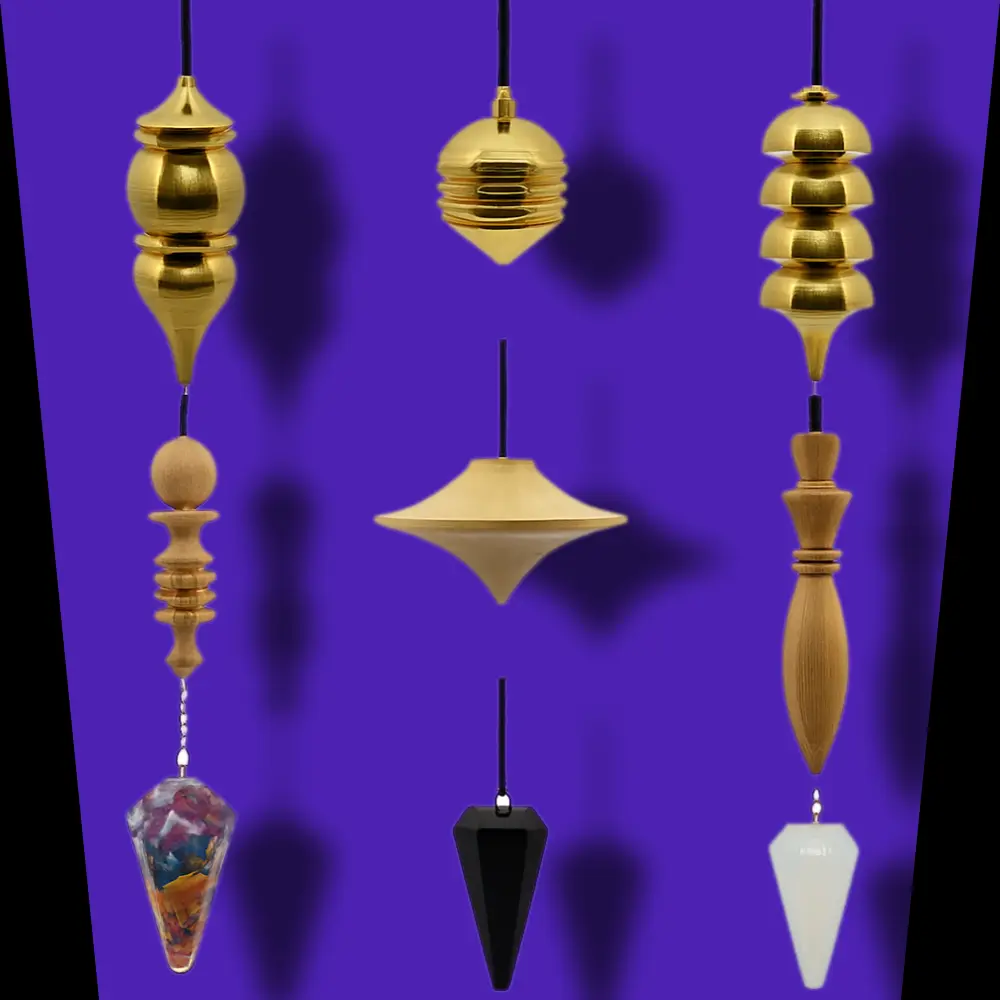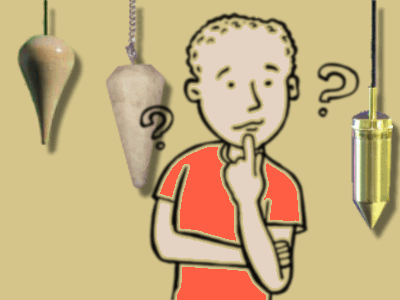Understanding pendulums and dowsing rods
An Introduction to the World of Pendulums and Dowsing Rods
For centuries, pendulums and dowsing rods have been used to detect subtle energies, locate water, and explore intuition. These simple yet powerful instruments respond to micro-movements and energetic fields, helping practitioners uncover insights that go beyond logic.
Whether drawn to the precision of brass, the resonance of crystal, or the organic warmth of wood, understanding how these tools work can deepen both awareness and results. Below, discover how to choose the instruments that best align with your purpose.

Types of Dowsing Tools
Dowsing tools come in many forms, each designed to interpret and respond to subtle energetic or muscular cues in its own way. The two most widely used are pendulums and dowsing rods — precision instruments that translate the dowser’s micro-movements into clear, visible motion. Their effectiveness depends on balance, design, and how smoothly they react to the practitioner’s intent and conditioning.
Both tools operate on the same fundamental principle: they act as extensions of the dowser’s sensitivity, amplifying minute impulses into readable responses. A pendulum is ideal for fine-tuned, stationary work such as map dowsing, energy testing, or intuitive inquiry, while dowsing rods excel at broader field exploration, locating underground water, or mapping subtle energy lines.
Understanding the unique strengths of each tool will help you select the one best suited to your purpose — whether for daily practice, professional energy work, or simple curiosity about the world’s hidden patterns.
Pendulums
Dowsing with a pendulum is both an art and a skill that develops through experience. A pendulum acts as an extension of your nervous system, translating subtle muscular responses and energetic cues into visible movement. Even experienced dowsers can encounter fluctuating results because of changes in weather, geomagnetic conditions, or personal energy levels. A well-balanced, finely crafted pendulum helps minimize interference, allowing clearer, more consistent responses.
Pendulums are among the most versatile dowsing tools. You can use them to locate objects, test energy flow, select remedies, or receive intuitive guidance. Because they are compact and highly responsive, pendulums are ideal for both beginners and professionals — equally suited to quiet desk work, field investigations, or therapeutic settings where sensitivity and precision are essential.
At Adermark, I offer a selection of brass pendulums, wood pendulums, and crystal pendulums, each designed for precision, balance, and durability. Every pendulum is balanced, has a smooth swing, and has reliable point alignment. While any pendulum can perform general dowsing tasks, the material and design often influence the pendulum’s feel and responsiveness in the hand.
For example, brass pendulums are valued for their stability and clarity of motion, making them dependable for analytical or map dowsing. Crystal pendulums amplify subtle energy, enhancing sensitivity and resonance during energetic or healing work. Wood pendulums, on the other hand, provide a light, natural touch that is ideal when working near electronics, ambient energy fields, or environments sensitive to metal. Many dowsers keep several pendulums in their pendulum pouch, selecting the one that best matches their purpose, mood, or environment — much like an artist choosing the perfect brush for a specific stroke.
When used regularly, a pendulum becomes finely attuned to its owner’s energy. Over time, you’ll notice smoother motion, quicker responses, and a growing sense of intuitive accuracy. Like any instrument, the pendulum performs best when treated with care, intention, and respect. The more familiar you become with its rhythm and balance, the more confidently you’ll interpret its guidance.
For deeper insight into choosing the right pendulum for your needs, see my article:
Selecting a Pendulum: Understanding the Differences
Dowsing Rods
Dowsing rods — also known as divining rods — represent another essential branch of dowsing practice. These tools, made with precision, help with every kind of dowsing assignment, from finding water, oil, minerals, and gold to exploring energy work, healing, and intuitive discovery. Whether you’re an experienced dowser or just beginning to explore the art, quality rods can make a significant difference in responsiveness and accuracy.
People often use a pendulum when they are seated or working in a focused indoor space, such as at a desk or with a client. Dowsing rods, by contrast, lend themselves to movement and open environments. They respond to the same subtle muscular and energetic cues as a pendulum, but because they are held in one or both hands, they provide a broader directional response that’s ideal for mapping energy fields, exploring terrain, or locating underground water lines and mineral deposits.
The most common forms of rod are the L-rod and Bobber rods, The L-rods are bent at a right angle and balanced for smooth, friction-free motion, and bobbers are straight. These rods can be used singly or as a pair. As the dowser walks or moves through an area, the rods cross, open, or swing in response to subtle shifts in energy or intent. Some dowsers also use Y-rods, traditionally cut from hazel, willow, or peach wood, which function similarly but are held in both hands as a single forked branch.
At Adermark, I offer a range of brass rods and stainless-steel dowsing rods crafted for durability, balance, and smooth action. Each rod is tested for even movement and alignment to ensure accurate feedback. These materials resist warping and corrosion, maintaining their performance over time. A well-made rod should pivot, swing or rotate freely with minimal resistance, allowing your body’s own micro-movements to produce clear directional signals.
When searching for underground water, mapping energy lines, or exploring the boundaries of a space, dowsing rods allow you to walk naturally across the ground while still receiving clear responses. Many practitioners keep both pendulums and rods in their toolkit — the pendulum for fine-tuned, stationary questions, and the rods for fieldwork and spatial exploration.
Like pendulums, dowsing rods respond best when you’ve taken time to establish a personal connection through use and intention. The more familiar you become with their balance and movement, the more confidently you can interpret their signals and rely on their guidance.









